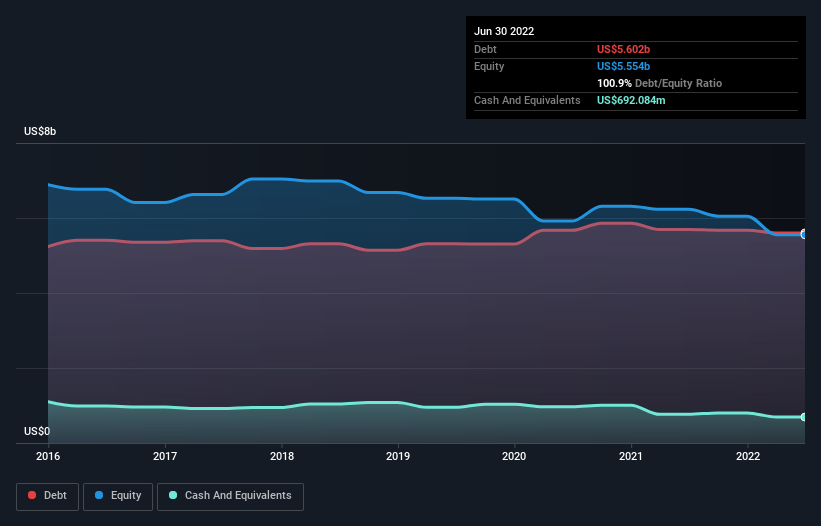Legendary fund manager Li Lu (who Charlie Munger backed) once said, 'The biggest investment risk is not the volatility of prices, but whether you will suffer a permanent loss of capital.' When we think about how risky a company is, we always like to look at its use of debt, since debt overload can lead to ruin. Importantly, Shangri-La Asia Limited (HKG:69) does carry debt. But the more important question is: how much risk is that debt creating?
When Is Debt Dangerous?
Debt and other liabilities become risky for a business when it cannot easily fulfill those obligations, either with free cash flow or by raising capital at an attractive price. Part and parcel of capitalism is the process of 'creative destruction' where failed businesses are mercilessly liquidated by their bankers. While that is not too common, we often do see indebted companies permanently diluting shareholders because lenders force them to raise capital at a distressed price. Of course, plenty of companies use debt to fund growth, without any negative consequences. The first thing to do when considering how much debt a business uses is to look at its cash and debt together.
Check out our latest analysis for Shangri-La Asia
What Is Shangri-La Asia's Debt?
As you can see below, Shangri-La Asia had US$5.60b of debt, at June 2022, which is about the same as the year before. You can click the chart for greater detail. However, it does have US$692.1m in cash offsetting this, leading to net debt of about US$4.91b.

A Look At Shangri-La Asia's Liabilities
We can see from the most recent balance sheet that Shangri-La Asia had liabilities of US$1.33b falling due within a year, and liabilities of US$5.80b due beyond that. On the other hand, it had cash of US$692.1m and US$284.9m worth of receivables due within a year. So its liabilities outweigh the sum of its cash and (near-term) receivables by US$6.15b.
This deficit casts a shadow over the US$2.91b company, like a colossus towering over mere mortals. So we definitely think shareholders need to watch this one closely. After all, Shangri-La Asia would likely require a major re-capitalisation if it had to pay its creditors today. When analysing debt levels, the balance sheet is the obvious place to start. But it is future earnings, more than anything, that will determine Shangri-La Asia's ability to maintain a healthy balance sheet going forward. So if you want to see what the professionals think, you might find this free report on analyst profit forecasts to be interesting.
Over 12 months, Shangri-La Asia reported revenue of US$1.3b, which is a gain of 17%, although it did not report any earnings before interest and tax. We usually like to see faster growth from unprofitable companies, but each to their own.
Caveat Emptor
Importantly, Shangri-La Asia had an earnings before interest and tax (EBIT) loss over the last year. Its EBIT loss was a whopping US$309m. Considering that alongside the liabilities mentioned above make us nervous about the company. We'd want to see some strong near-term improvements before getting too interested in the stock. Not least because it had negative free cash flow of US$256m over the last twelve months. That means it's on the risky side of things. For riskier companies like Shangri-La Asia I always like to keep an eye on whether insiders are buying or selling. So click here if you want to find out for yourself.
If you're interested in investing in businesses that can grow profits without the burden of debt, then check out this free list of growing businesses that have net cash on the balance sheet.
New: Manage All Your Stock Portfolios in One Place
We've created the ultimate portfolio companion for stock investors, and it's free.
• Connect an unlimited number of Portfolios and see your total in one currency
• Be alerted to new Warning Signs or Risks via email or mobile
• Track the Fair Value of your stocks
Have feedback on this article? Concerned about the content? Get in touch with us directly. Alternatively, email editorial-team (at) simplywallst.com.
This article by Simply Wall St is general in nature. We provide commentary based on historical data and analyst forecasts only using an unbiased methodology and our articles are not intended to be financial advice. It does not constitute a recommendation to buy or sell any stock, and does not take account of your objectives, or your financial situation. We aim to bring you long-term focused analysis driven by fundamental data. Note that our analysis may not factor in the latest price-sensitive company announcements or qualitative material. Simply Wall St has no position in any stocks mentioned.
About SEHK:69
Shangri-La Asia
An investment holding company, develops, owns/leases, operates, and manages hotels and associated properties worldwide.
Moderate growth potential second-rate dividend payer.
Similar Companies
Market Insights
Community Narratives



